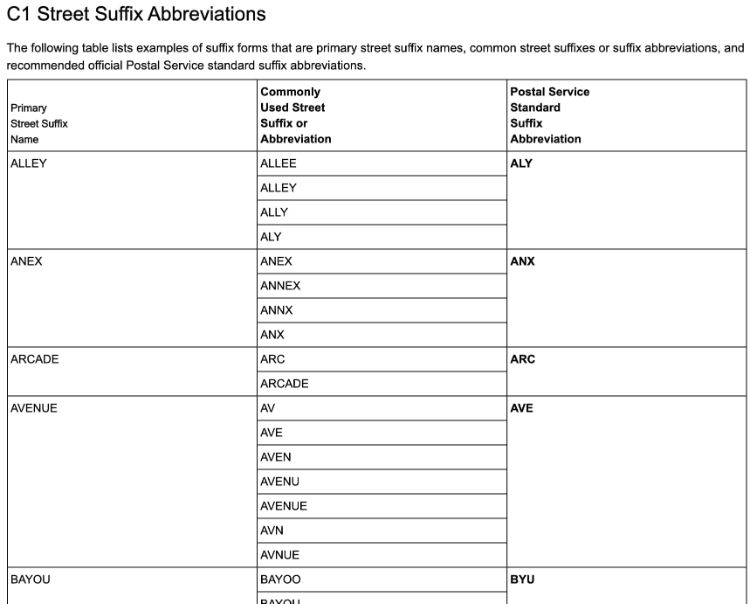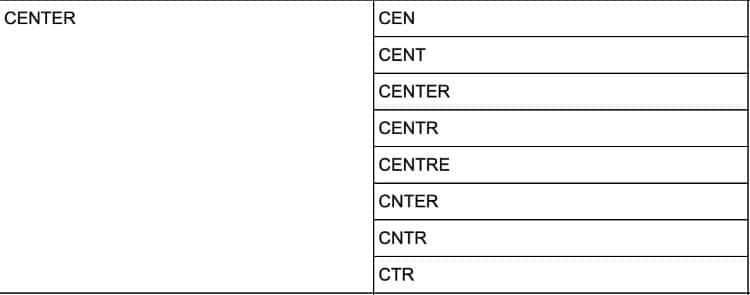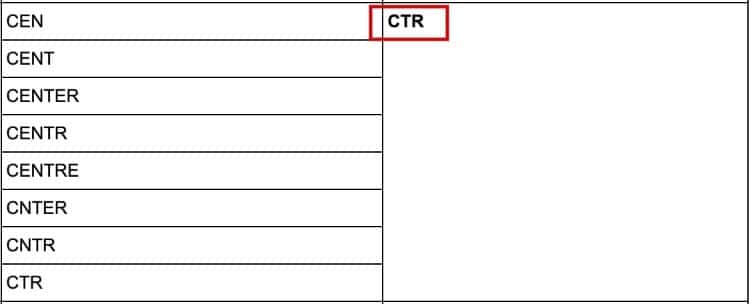Address standardization | What it is & how to do it

Address Standardization (or Address Normalization) is the process of converting an address into a standardized, consistent format of the local postal authority such as the USPS for US addresses, or La Poste for France.
Address standardization includes correcting errors, adding missing components, abbreviating words, and transforming the address into a common, recognized structure.
Common goals of normalization are improving address accuracy and delivery, merging large address datasets, and facilitating the use of addresses in geographic information systems, and other data applications.
Smarty performs lightning-fast international, non-postal, and USPS address standardization. Start validating and standardizing addresses to any country's standard address format by clicking one of the buttons below, or continue reading to learn more about the standardization/normalization process.
|
Single Address Standardization - Standardize addresses one at a time. |
Bulk Address Standardization - Standardize a list of addresses all at once. |
Address Standardization APIs - Programmatically standardize addresses. |
Table of contents
- Video: What is international and USPS address standardization?
- How do you standardize (or normalize) address records?
- What is CASS address standardization?
- What is my USPS standardized address?
- Standardization for project managers and database administrators
- Conclusion
Video: What Is international and USPS address standardization?
The process of standardizing an address can differ significantly depending on the address's country or territory, language, character set, local reading & writing conventions, and the country's local postal authority guidelines. Unsurprisingly, there isn't a single accepted standard address format guaranteed to work globally. USPS address standardization is simply the standard address format for US addresses.
The USPS defines a standardized address as "one that is fully spelled out, abbreviated by using the Postal Service standard address abbreviations... or as shown in the current Postal Service ZIP+4 suffix file." 1
Whether an address is standardized according to the USPS guidelines or one of the many international address formats, standardization is best when it's baked into address validation software. Address standardization CAN'T tell you if an address is valid. The address normalization process only converts an address into the correct format. Validating an address means the standardized address is compared against an authoritative address database to look for a match. If found, the address is "valid". If not found, the address is "invalid."
Once standardized and validated, the address will be complete, including the addition of any missing city, state, or Postal Code information. All the individual address components will be formatted with USPS-approved spelling and street abbreviations in the approved USPS address format or the applicable international address format.
There are many business use cases for address standardization and validation outside of shipping. You can learn about in our 5 Ways Companies Use Address Verification to Improve Business Results ebook. Access it here:

Examples of address standardization
Remember, we first normalize an address and then verify it. We've demonstrated this in the following table.
|
Street address as typed by an individual |
Standardized address formats |
|
post office box 121 Abbeeville, Albamba |
PO Box 121 Abbeville AL 36310-0121 |
|
2993 Johnson Wantagh New York state 11793 |
2993 Johnson Pl Wantagh NY 11793-2836 |
|
2701 phillips Ave., charlotte, N.C. |
2701 Phillips Ave Charlotte NC 28208-7029 |
|
616 ivory rio rancho NM, 87124 |
616 Ivory Rd SE Rio Rancho NM 87124-3042 |
What about casing & capitalization?
We're all used to seeing addresses like this:
772 W ROLLING RD
SPRINGFIELD PA 19054-1132
Uppercase text, however, isn't a USPS address standardization requirement.2 The text simply needs to be clearly printed and meet USPS OCR address standards. Addresses do not need to be all capitalized. So the uppercase lettering within an address format is as valid as the following address format:
772 W Rolling Rd
Springfield PA 19054-1132
Smarty returns address results in Proper Case rather than UPPERCASE. If you prefer uppercase formatting, you can transform text to ALL UPPERCASE using any spreadsheet program, database application, or programming language.
How do you standardize (or normalize) address records?
Address standardization (or address normalization) is an easy process for most addresses. Address standardization and address normalization can be used synonymously.
Generally, there are two ways to approach address standardization. You can either use software, or you can standardize addresses manually. Explore our property data article for more information on standardizing addresses and appending valuable property attributes in your data.
Option 1: Address standardization software
Whether you have to standardize one address or millions, using address normalization software will make your job easier.
The software will automatically correct for malformed addresses. This process, done manually, could take you several days to complete, depending on the volume of addresses you need standardized. Many address data verification software tools are free to try. Take ours for a test drive and see how address normalization works.
Option 2: Do it yourself (DIY)
Another option for standardizing addresses is to attempt to do it manually yourself. Here are the basic steps required for the US mailing address format for the majority of US addresses. For the sake of maintaining your sanity and ours; we won't cover all the special cases that standardization software will handle automatically.
- Get the address you want to standardize.
- Fix any misspellings.
- Check the street name, city, and state. Verify that all address information is correct.
- Correct any abbreviations.
- There is only one correct version of each abbreviation according to the postal service. Check out this library to find the list of USPS-approved abbreviations along with their variants.

For example, if the pre-standardized address format looked like this:
1 CHATHAM Center
Pittsburgh, Pennsylvania, 15219
The word “Center” is commonly abbreviated in the following ways, but which abbreviation is correct?

If you answered, “CTR,” then congratulations! You were correct on one of the hundreds of abbreviation variants out there!

You can use the linked library to get your corrected USPS address abbreviations.
- Correct casing and capitalization.
- Like we explained in the “What about casing & capitalization?” section, the United States Postal Service will accept either UPPERCASE format or Proper Case.
- Get the ZIP+4 (the extra 4 digits you append to a 5-digit ZIP Code ).
-
The ZIP+4 Code is optional. However, by including it,
mail can arrive up to 2 days faster. ZIP+4 Codes apply to only 10-20 homes or locations.
Appending the ZIP+4 means the Post Office can more easily pinpoint where your mail needs to
go. With 160 million delivery points in the US, there are between 8 million and 16 million
ZIP+4 Codes out there, and they can change up to once a month.
Trying to figure out ZIP+4 for each address on your own can feel like trying to hit a moving target 160 million times in a row, so you can leave it off if you like. A better option would be to use our ZIP+4 web tool to find yours in a few seconds. It will also do the standardizing and verifying of your address as a bonus. - Celebrate because you're done standardizing your address!
- The address should now have the correct USPS address format. Doesn't that feel good? It will look something like this:
1 Chatham Ctr
Pittsburgh PA 15219-3441
What is CASS address standardization?
CASS Address standardization is the Coding Accuracy Support System. Developed by the United States Postal Service, it's a certification program for standardization and address verification. A CASS-certified software will standardize your mailing lists, update outdated addresses, and will verify that the addresses are complete and valid. For the latest iteration check out our, CASS Cycle O article here.
So, how does address standardization differ from CASS address standardization?
Address standardization is the process of formatting an address to conform to USPS guidelines.
CASS address standardization is a certification that a particular service has been certified by USPS that it can standardize addresses according to USPS guidelines.
There are also other forms of address standardization, for example, many countries adhere to their own address standardization format. Another example is Project US@ which is a set of technical guidelines and standards specific toe the US healthcare industry.
Smarty is a CASS-certified software provider, which is why we can standardize your addresses to the USPS format for you. You can test it here.
What is my USPS standardized address?
I bet you just skipped down to this section. If so, I can't blame you. It's the most important question, and I am glad you asked! Coincidentally enough, we actually have address standardization software you can use to find your own USPS standardized address!
Smarty's Address Standardization API not only standardizes but also validates addresses, ensuring they are both correctly formatted and real.
In the address standardization rules section of this article, we mentioned that standardization puts your address in a standard form that is recognized by the United States Postal Service. What address standardization doesn't do is it doesn't check to ensure that the address is actually valid. However, our software both standardizes and validates addresses. Just give a quick clickity-click here, pop in your address, and you will have your standardized and validated address in a few seconds.
Our software can standardize and validate addresses from multiple databases making many additional scrubbing processes obsolete. Whether you're standardizing for a SQL database or need a Python, Java SDK, or other API solutions; we can help you.
Standardization for project managers and database administrators
So, you're a Project Manager or a Database Administrator (DBA) that works for Blue Widgets Incorporated. You have been tasked with merging three databases of customer data. Each database originates from different sales channels. You have a SQL database of customers for eBay, a CSV file for Amazon customer data, and a list of customers' corporate websites from a CRM.
Now, your company wants to send catalogs to its top 50,000 customers.
You could be facing a number of problems in trying to accomplish this. The first issue is that each of these platforms holds address data in different formats. One of these might be a fully standardized address database that needs no additional effort, while the others might need a lot of work. One might break address components down into 7 different fields, while the other databases might put the full address into a single field. Another issue is that your customers might exist simultaneously in more than one database because they have purchased from you on multiple platforms.
So, how can you ensure you aren't sending multiple catalogs to a single address? What about wasting money by sending mail to invalid addresses? You can eliminate this waste by doing some data cleansing (scrubbing) in your databases. For mailing addresses, this consists of three steps.
- Standardization - By parsing your different addresses and putting them in the one consistent format as defined by the USPS, you make sure each address is in the format with the correct syntax that will be most understandable for the next steps.
- Validation - Address validation involves doing an address lookup for addresses in the USPS standardized address database. This database is updated monthly. This step ensures the address is actually a current, valid, mailable address.
- De-duplication - Once the addresses are standardized and validated, it's now easy to eliminate duplicates. Now, the address only appears in your merged, standardized address database one time. If you did de-duplication before standardizing and validating, many duplicate addresses would be missed.
You have completed the cleanse. Standardizing, validating, and removing duplicates are important steps in data management hygiene.
If an address is worth keeping it will be standardized and validated. Integrating regular scrubbing into your databases of addresses makes them reliable. With reliable addresses, you can better track the lifetime value of your customers and more clearly see their purchase patterns. Not to mention the money you can save by reducing postage on undeliverable mail now that you have reliable customer address records.
Learn about these use cases and more in our 5 Ways Companies Use Address Verification to Improve Business Results ebook. Access it here:

Conclusion
Using an address standardization service makes addresses as easy to understand as possible for the USPS, and computer databases. It does this by putting all addresses in a simple standard format. Standardization factors in spelling, casing, abbreviations, postal codes, and many more special cases. And, after finishing this article, you now have all the address standardization tools you need to validate your addresses.
To easily standardize one address or many, try Smarty's address validation service for free. We've got a postal address validator. We also have a bulk address validator. Best of all, we've got a collection of validation APIs so that you can standardize addresses in your own programs or forms.